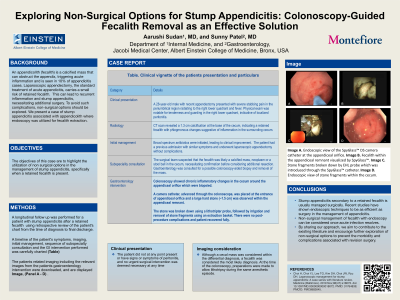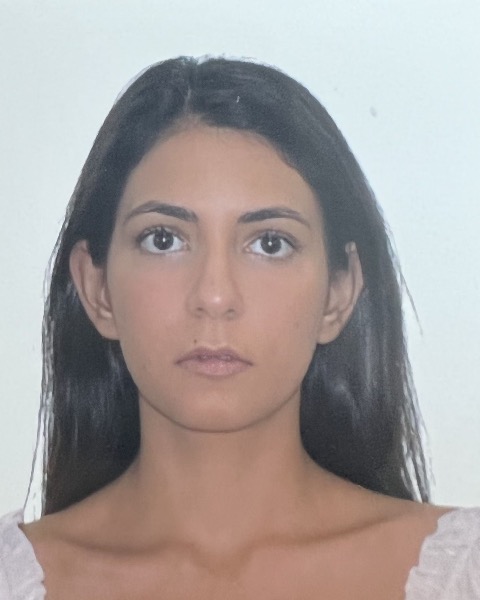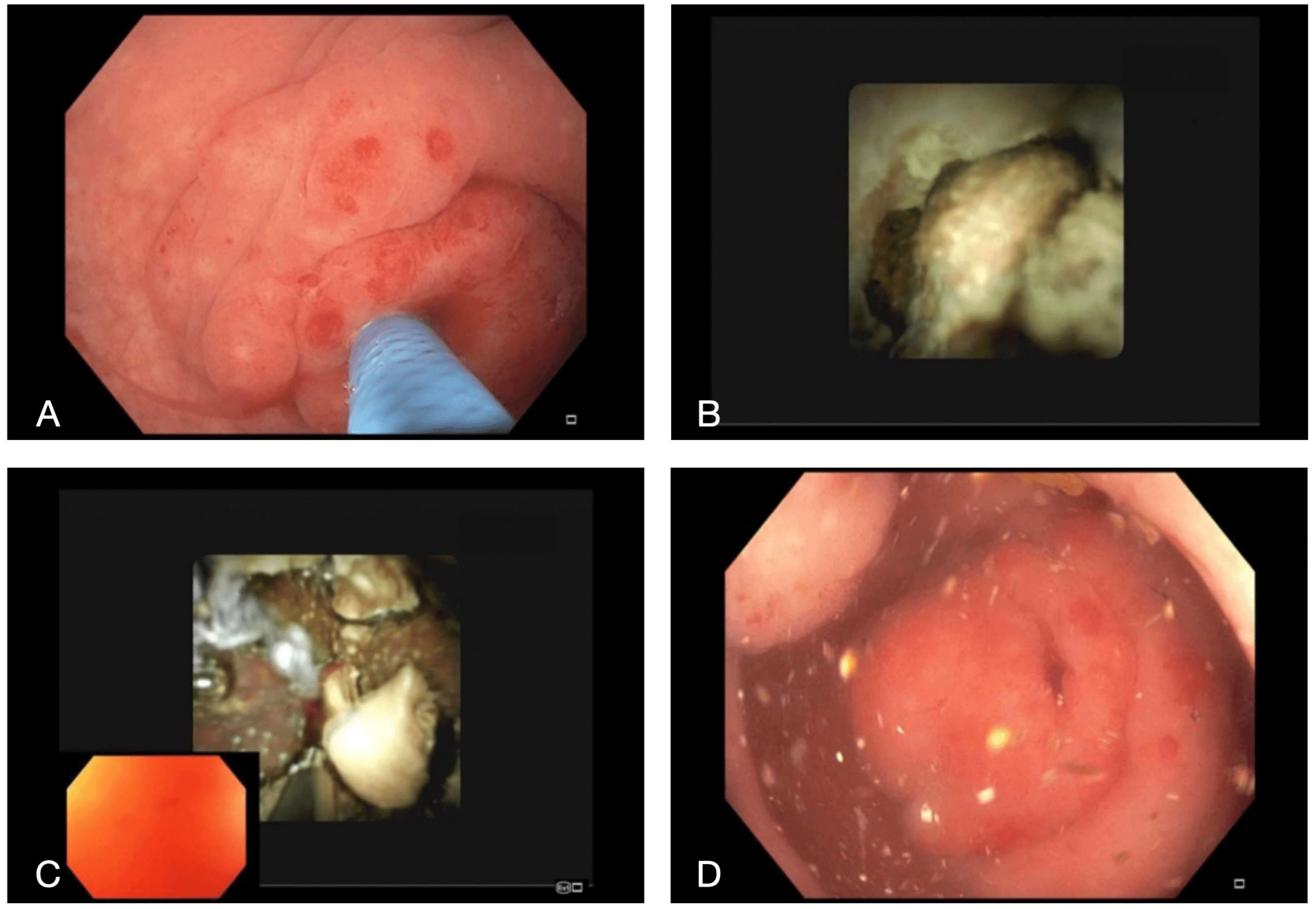Tuesday Poster Session
Category: Interventional Endoscopy
P3762 - Exploring Non-Surgical Options for Stump Appendicitis: Colonoscopy-Guided Fecalith Removal as an Effective Solution
Tuesday, October 24, 2023
10:30 AM - 4:00 PM PT
Location: Exhibit Hall

Has Audio

Aarushi Sudan, MD
Jacobi Medical Center
New York, New York
Presenting Author(s)
Aarushi Sudan, MD, Sunny Patel, MD
Jacobi Medical Center, New York, NY
Introduction: An appendicolith (fecalith) is a calcified mass that can obstruct the appendix, triggering acute inflammation, and is seen in 10% of appendicitis cases. Laparoscopic appendectomy, the standard treatment of acute appendicitis, carries a small risk of retained fecalith. This can lead to recurrent inflammation and stump appendicitis, necessitating additional surgery. To avoid such complications, nonsurgical options should be explored. We present a case of stump appendicitis associated with fecalith where endoscopy was utilized for fecalith extraction.
Case Description/Methods: A 28-year-old male with recent appendectomy presented with severe stabbing pain in the periumbilical region radiating to the right lower quadrant and fever. Physical exam was notable for tenderness and guarding in the right lower quadrant, indicative of localized peritonitis. CT scan revealed a 1.3 cm calcification at the base of the cecum, indicating a retained fecalith with phlegmonous changes suggestive of inflammation in the surrounding cecum. Broad-spectrum antibiotics were initiated, leading to clinical improvement. The patient had a previous admission with similar symptoms and underwent laparoscopic appendectomy without complications. Surgeons suspected recurrent appendicitis secondary to fecalith. Initial management was repeat surgery with ileocecal resection, but patient declined and wanted to explore non-surgical options. Gastroenterology was consulted for endoscopic management of fecalith.
Colonoscopy showed chronic inflammatory changes in the cecum around the appendiceal orifice which were biopsied. A SpyGlass™ Direct Visualization system was advanced through the colonoscope and used to directly visualize the appendiceal orifice. A large hard stone (~1.5 cm) was seen within the appendiceal remnant and broken down using electrohydraulic lithotripsy, followed by irrigation and removal of stone fragments using an extraction basket. There were no post-procedure complications and patient recovered fully.
Discussion: Stump appendicitis secondary to a retained fecalith is usually managed surgically. Recent studies have shown endoscopic techniques to be as efficient as surgery in the management of appendicitis. Non-surgical management of fecalith with endoscopy can be considered once acute infection resolves. By sharing our approach, we aim to contribute to the existing literature and encourage further exploration of non-surgical options to prevent the morbidity and complications associated with revision surgery.

Disclosures:
Aarushi Sudan, MD, Sunny Patel, MD. P3762 - Exploring Non-Surgical Options for Stump Appendicitis: Colonoscopy-Guided Fecalith Removal as an Effective Solution, ACG 2023 Annual Scientific Meeting Abstracts. Vancouver, BC, Canada: American College of Gastroenterology.
Jacobi Medical Center, New York, NY
Introduction: An appendicolith (fecalith) is a calcified mass that can obstruct the appendix, triggering acute inflammation, and is seen in 10% of appendicitis cases. Laparoscopic appendectomy, the standard treatment of acute appendicitis, carries a small risk of retained fecalith. This can lead to recurrent inflammation and stump appendicitis, necessitating additional surgery. To avoid such complications, nonsurgical options should be explored. We present a case of stump appendicitis associated with fecalith where endoscopy was utilized for fecalith extraction.
Case Description/Methods: A 28-year-old male with recent appendectomy presented with severe stabbing pain in the periumbilical region radiating to the right lower quadrant and fever. Physical exam was notable for tenderness and guarding in the right lower quadrant, indicative of localized peritonitis. CT scan revealed a 1.3 cm calcification at the base of the cecum, indicating a retained fecalith with phlegmonous changes suggestive of inflammation in the surrounding cecum. Broad-spectrum antibiotics were initiated, leading to clinical improvement. The patient had a previous admission with similar symptoms and underwent laparoscopic appendectomy without complications. Surgeons suspected recurrent appendicitis secondary to fecalith. Initial management was repeat surgery with ileocecal resection, but patient declined and wanted to explore non-surgical options. Gastroenterology was consulted for endoscopic management of fecalith.
Colonoscopy showed chronic inflammatory changes in the cecum around the appendiceal orifice which were biopsied. A SpyGlass™ Direct Visualization system was advanced through the colonoscope and used to directly visualize the appendiceal orifice. A large hard stone (~1.5 cm) was seen within the appendiceal remnant and broken down using electrohydraulic lithotripsy, followed by irrigation and removal of stone fragments using an extraction basket. There were no post-procedure complications and patient recovered fully.
Discussion: Stump appendicitis secondary to a retained fecalith is usually managed surgically. Recent studies have shown endoscopic techniques to be as efficient as surgery in the management of appendicitis. Non-surgical management of fecalith with endoscopy can be considered once acute infection resolves. By sharing our approach, we aim to contribute to the existing literature and encourage further exploration of non-surgical options to prevent the morbidity and complications associated with revision surgery.

Figure: Image A. Endoscopic view of the SpyGlass™ DS camera catheter at the appendiceal orifice. Image B. Fecalith within the appendiceal remnant visualized by SpyGlass™. Image C. Stone fragments broken down by EHL probe which was introduced through the SpyGlass™ catheter. Image D. Endoscopic view of stone fragments within the cecum.
Disclosures:
Aarushi Sudan indicated no relevant financial relationships.
Sunny Patel indicated no relevant financial relationships.
Aarushi Sudan, MD, Sunny Patel, MD. P3762 - Exploring Non-Surgical Options for Stump Appendicitis: Colonoscopy-Guided Fecalith Removal as an Effective Solution, ACG 2023 Annual Scientific Meeting Abstracts. Vancouver, BC, Canada: American College of Gastroenterology.
